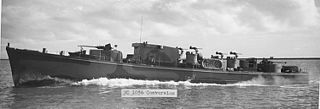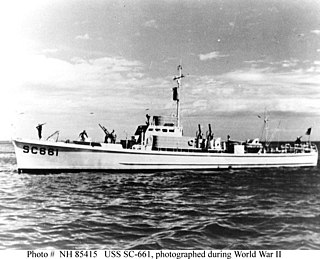
A patrol boat is a relatively small naval vessel generally designed for coastal defence, border security, or law enforcement. There are many designs for patrol boats, and they generally range in size. They may be operated by a nation's navy, coast guard, police, or customs, and may be intended for marine, estuarine, or river environments.

The Asheville-class gunboats were a class of small warships built for the United States Navy in response to the Cuban Missile Crisis. The class is named for a city in western North Carolina and the seat of Buncombe County. All Asheville-class gunboats have since been donated to museums, scheduled for scrapping, or transferred to the Greek, Turkish, Colombian and South Korean Navies. The last two Asheville-class gunboats in US service were USS Chehalis and USS Grand Rapids, which were operated by the Naval Surface Warfare Center until they were stricken in 2016.

USS Jamestown (PG-55) was a patrol gunboat and after 13 January 1943 a Jamestown-class motor torpedo boat tender acquired by the U.S. Navy during World War II. Her task in her final classification was to provide a "home base" for torpedo boats in remote parts of the ocean during the war, and to provide them with necessary services, such as fuel, food, and repairs.

USS PGM-7 was a gunboat that served in the United States Navy during World War 2. She was commissioned as USS SC-1072, an SC-497 Class Submarine Chaser on 28 June 1943. She was reclassified as a PGM-1 Class Motor Gunboat on 10 December 1943. She was dispatched to the Solomon Islands for patrol service.

The PGM-1-class motor gunboats were a class of eight gunboats converted for the United States Navy from 1943 to 1944 and were succeeded by the PGM-9-class motor gunboats. All eight PGM-1s were converted from SC-497-class submarine chasers. The PGM-1s were created to support PT boats in the Pacific, but were too slow to keep up. The PGM-1s were discontinued and the PGM-9s, also too slow, were shifted to support minesweeping ships instead.

USS PGM-1 was a PGM-1 class motor gunboat that served in the United States Navy during World War II.

USS PGM-2 was a PGM-1 class motor gunboat that served in the United States Navy during World War II. She was originally laid down as an SC-497 class submarine chaser on 16 July 1942 by the Robinson Marine in Benton Harbor, Michigan and launched on 17 June 1943. She was commissioned as USS SC-757 on 12 August 1943. She was later converted to a PGM-1 class motor gunboat and renamed PGM-2 on 10 December 1943. After the war she was sold and transferred to the Foreign Liquidations Commission at Subic Bay, Philippines on 20 May 1947. Her exact fate is unknown.

USS PGM-4 was a PGM-1 class motor gunboat that served in the United States Navy during World War II. She was originally laid down as an SC-497 class submarine chaser on 11 April 1942 by the Wilmington Boat Works, Inc. in Wilmington, California and launched on 7 September 1942. She was commissioned as USS SC-1053 on 17 March 1943. She was later converted to a PGM-1 class motor gunboat and renamed PGM-4 on 10 December 1943. After the war she was transferred to the Foreign Liquidations Commission on 9 June 1947. Her exact fate is unknown.

USS PGM-5 was a PGM-1 class motor gunboat that served in the United States Navy during World War II. She was originally laid down as an SC-497 class submarine chaser on 14 May 1942 by the Wilmington Boat Works in Wilmington, California and launched on 2 November 1942. She was commissioned as USS SC-1056 on 15 June 1943. She was later converted to a PGM-1 class motor gunboat and renamed PGM-5 on 10 December 1943. After the war she was transferred to the Foreign Liquidations Commission on 7 May 1947. Her exact fate is unknown.

USS PGM-6 was a PGM-1 class motor gunboat that served in the United States Navy during World War II. She was originally laid down as a SC-497 class submarine chaser on 6 February 1943 by the Mathis Yacht Building Company in Camden, New Jersey and launched on 20 May 1943. She was commissioned as USS SC-1071 on 8 June 1943. She was later converted to a PGM-1 class motor gunboat and renamed PGM-6 on 10 December 1943. During the war she took part in the Pacific Theater. After the war she was transferred to the Foreign Liquidations Commission on 7 May 1947. Her exact fate is unknown.

USS PGM-8 was a PGM-1 class motor gunboat that served in the United States Navy during World War II. She was originally laid down as a SC-497 class submarine chaser on 2 November 1942 by the Wilmington Boat Works in Wilmington, California and launched on 1 May 1943. She was commissioned as USS SC-1366 on 12 August 1943. She was later converted to a PGM-1 class motor gunboat and renamed PGM-8 on 10 December 1943. After the war she was transferred to the Foreign Liquidations Commission in May 1947. Her exact fate is unknown.

The SC-497-class submarine chasers were a class of 438 submarine chasers built primarily for the United States Navy from 1941–1944. The SC-497s were based on the experimental submarine chaser, USS SC-453. Submarine chasers of this variety were collectively nicknamed "the splinter fleet" due to their wooden hulls.

The second USS Benicia (PGM-96/PG-96) was a Asheville-class gunboat in the United States Navy commissioned in 1970. She later served in the South Korean Navy as Paek Ku 51 (PGM-351).

The second USS Grand Rapids (PGM-98/PG-98) was an Asheville-class gunboat in the United States Navy during the Vietnam War.

The PC-461-class submarine chasers were a class of 343 submarine chasers constructed mainly for the US Navy and built from 1941 to 1944. The PC-461s were based primarily on two experimental submarine chasers, PC-451 and PC-452. While PC-461 began the series, the first of the class to enter service was PC-471. As part of the Lend-Lease program, 46 ships of this class were transferred to allies of the United States. Fifty-nine PC-461s were converted to other types of patrol vessels. Eight vessels of this class were lost, and one vessel was lost after conversion to a PGM-9-class motor gunboat. Only one of the class, USS PC-566 commanded by Lieutenant Commander Herbert G. Claudius, actually sank a submarine, U-166, during World War II; however, the website 'Patrol Craft Sailors Association' cites PC-461-class ships sinking or assisting sinking up to 6 German and Japanese subs.

The Juneau-class cruisers were United States Navy light cruisers that were modified version of the Atlanta-class cruiser design. The ships had the same dual-purpose main armament as USS Oakland with a much heavier secondary antiaircraft battery, while the anti-submarine depth charge tracks and torpedo tubes were removed along with a redesigned superstructure to reduce weight and increase stability. Three ships were ordered and built, all completed shortly after World War II, but only Juneau remained active long enough to see action during the Korean War.

The PGM-39-class gunboats, designated Patrol Gunboat, Motor by the United States Navy were a class of fifty nine gunboats constructed in various shipyards from 1959–1970. The design was based on the United States Coast Guard Cape-class cutter design with a five-foot (1.5 m) hull extension. It was specifically designed for the U.S. Military Assistance Program and was used by the navies of The Philippines, Indonesia, South Vietnam, Thailand, Burma, Ethiopia, and Ecuador.

The Dubuque class gunboats were a class of gunboats built by the United States prior to World War I. The class was designed in 1903. The United States Navy commissioned 2 Dubuque-class gunboats in 1903. Dubuques had a design speed of 12 knots, and a main armament of six 4" rapid-fire guns and four 6-pounder rapid-fire guns in single mounts.
USS PGM-11 was a PGM-9-class motor gunboat in service with the United States Navy during World War II.

Wilmington Boat Works, Inc. or WILBO was a shipbuilding company in Wilmington, California. To support the World War 2 demand for ships Victory Shipbuilding built: Tugboats, crash rescue boats and sub chasers. Wilmington Boat Works opened in 1920 building Fishing boat and yachts, by Hugh Angelman, Willard Buchanan and Tom Smith. After the Korean War the shipyard closed in 1958. The shipyard was located at 400 Yacht Street, Wilmington, the site of the current USC boatyard.














